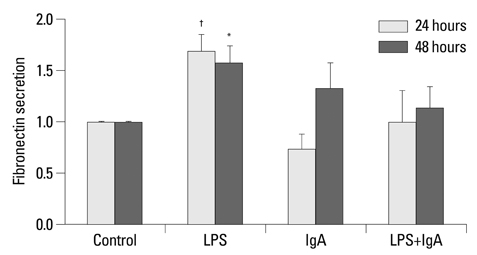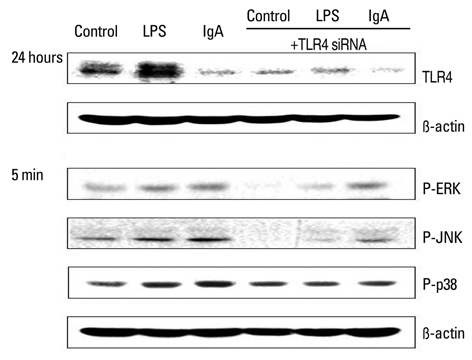Yonsei Med J.
2011 Jul;52(4):610-615. 10.3349/ymj.2011.52.4.610.
Toll-Like Receptor 4 Signaling is Involved in IgA-Stimulated Mesangial Cell Activation
- Affiliations
-
- 1Department of Pathology, Yonsei University College of Medicine, Seoul, Korea. jeong10@yuhs.ac
- KMID: 1727993
- DOI: http://doi.org/10.3349/ymj.2011.52.4.610
Abstract
- PURPOSE
Deposition of polymeric IgA1 in the kidney mesangium is the hallmark of IgA nephropathy, but the molecular mechanisms of IgA-mediated mesangial responses and inflammatory injuries remain poorly understood. We hypothesize that Toll-like receptor 4 (TLR4) is involved in IgA-induced mesangial cell activation.
MATERIALS AND METHODS
Mouse mesangial cells were stimulated with lipopolysaccharide (LPS) (1 microg/mL), IgA (20 microg/mL), or both, and TLR4 expression was measured by real time RT-PCR and Western blot. Intracellular responses to LPS or IgA were assessed by Western blot for ERK1/2, JNK, p38 MAP kinases (MAPKs), Ikappa-Balpha degradation and fibronectin secretion. MCP-1 secretion was assessed by ELISA. Small interfering RNA (siRNA) of TLR4 was used to confirm that the effects were caused by TLR4 activity.
RESULTS
LPS- or IgA-treatment upregulated the levels of TLR4 mRNA and protein in cultured MMC at 24 h. LPS and IgA induced rapid phosphorylation of MAPKs, but degradation of Ikappa-Balpha was observed only in LPS-treated MMC. LPS, but not IgA, induced increased secretion of MCP-1 and fibronectin at 24 h or 48 h. Combined LPS and IgA treatment did not cause additional increases in TLR4 mRNA and protein levels or Ikappa-Balpha degradation, and MCP-1 and fibronectin secretions were less than with LPS alone. LPS- or IgA-induced TLR4 protein levels and MAPK activation were inhibited by transfection with TLR4 siRNA.
CONCLUSION
These results indicate that the activation of MAPKs and MCP-1 secretion are mediated by TLR4, at least in part, in IgA-treated mesangial cells. TLR4 is involved in mesangial cell injury by induction of pro-inflammatory cytokines in IgA nephropathy.
Keyword
MeSH Terms
-
Animals
Chemokine CCL2/secretion
Enzyme-Linked Immunosorbent Assay
Extracellular Signal-Regulated MAP Kinases/metabolism
Fibronectins/secretion
Glomerulonephritis, IGA/*metabolism
I-kappa B Proteins/metabolism
Mesangial Cells/*metabolism/secretion
Mice
Mice, Transgenic
Phosphorylation
RNA Interference
RNA, Messenger/metabolism
*Signal Transduction
Toll-Like Receptor 4/antagonists & inhibitors/genetics/*metabolism
Figure
Reference
-
1. Akira S, Uematsu S, Takeuchi O. Pathogen recognition and innate immunity. Cell. 2006. 124:783–801.
Article2. Kawai T, Akira S. Pathogen recognition with Toll-like receptors. Curr Opin Immunol. 2005. 17:338–344.
Article3. Anders HJ, Schlöndorff D. Toll-like receptors: emerging concepts in kidney disease. Curr Opin Nephrol Hypertens. 2007. 16:177–183.
Article4. El-Achkar TM, Dagher PC. Renal Toll-like receptors: recent advances and implications for disease. Nat Clin Pract Nephrol. 2006. 2:568–581.
Article5. Kuki K, Gotoh H, Hayashi M, Hujihara K, Tamura S, Yamanaka N. Immunity of tonsil and IgA nephropathy--relationship between IgA nephropathy and tonsillitis. Acta Otolaryngol Suppl. 2004. 124:6–9.
Article6. Coppo R, Camilla R, Amore A, Peruzzi L, Daprà V, Loiacono E, et al. Toll-like receptor 4 expression is increased in circulating mononuclear cells of patients with immunoglobulin A nephropathy. Clin Exp Immunol. 2010. 159:73–81.
Article7. Patole PS, Pawar RD, Lech M, Zecher D, Schmidt H, Segerer S, et al. Expression and regulation of Toll-like receptors in lupus-like immune complex glomerulonephritis of MRL-Fas(lpr) mice. Nephrol Dial Transplant. 2006. 21:3062–3073.
Article8. Brown HJ, Lock HR, Wolfs TG, Buurman WA, Sacks SH, Robson MG. Toll-like receptor 4 ligation on intrinsic renal cells contributes to the induction of antibody-mediated glomerulonephritis via CXCL1 and CXCL2. J Am Soc Nephrol. 2007. 18:1732–1739.
Article9. Mattii L, Segnani C, Cupisti A, D'Alessandro D, Moscato S, Meola M, et al. Kidney expression of RhoA, TGF-beta1, and fibronectin in human IgA nephropathy. Nephron Exp Nephrol. 2005. 101:e16–e23.10. Kwon J, Park J, Lee D, Kim YS, Jeong HJ. Toll-like receptor expression in patients with renal allograft dysfunction. Transplant Proc. 2008. 40:3479–3480.
Article11. Suzuki H, Suzuki Y, Narita I, Aizawa M, Kihara M, Yamanaka T, et al. Toll-like receptor 9 affects severity of IgA nephropathy. J Am Soc Nephrol. 2008. 19:2384–2395.
Article12. Allen AC, Harper SJ, Feehally J. Galactosylation of N- and O-linked carbohydrate moieties of IgA1 and IgG in IgA nephropathy. Clin Exp Immunol. 1995. 100:470–474.
Article13. Wolf G, Bohlender J, Bondeva T, Roger T, Thaiss F, Wenzel UO. Angiotensin II upregulates toll-like receptor 4 on mesangial cells. J Am Soc Nephrol. 2006. 17:1585–1593.
Article14. Chen HC, Guh JY, Tsai JH, Lai YH. Induction of heat shock protein 70 protects mesangial cells against oxidative injury. Kidney Int. 1999. 56:1270–1273.
Article15. Lim BJ, Hong SW, Jeong HJ. Renal tubular expression of Toll-like receptor 4 in cyclosporine nephrotoxicity. APMIS. 2009. 117:583–591.
Article16. Duque N, Gómez-Guerrero C, Egido J. Interaction of IgA with Fc alpha receptors of human mesangial cells activates transcription factor nuclear factor-kappa B and induces expression and synthesis of monocyte chemoattractant protein-1, IL-8, and IFN-inducible protein 10. J Immunol. 1997. 159:3474–3482.17. Ka SM, Cheng CW, Shui HA, Wu WM, Chang DM, Lin YC, et al. Mesangial cells of lupus-prone mice are sensitive to chemokine production. Arthritis Res Ther. 2007. 9:R67.
Article18. Wolf HM, Hauber I, Gulle H, Samstag A, Fischer MB, Ahmad RU, et al. Anti-inflammatory properties of human serum IgA: induction of IL-1 receptor antagonist and Fc alpha R (CD89)-mediated down-regulation of tumour necrosis factor-alpha (TNF-alpha) and IL-6 in human monocytes. Clin Exp Immunol. 1996. 105:537–543.
Article19. Olas K, Butterweck H, Teschner W, Schwarz HP, Reipert B. Immunomodulatory properties of human serum immunoglobulin A: anti-inflammatory and pro-inflammatory activities in human monocytes and peripheral blood mononuclear cells. Clin Exp Immunol. 2005. 140:478–490.
Article20. Shimosawa M, Sakamoto K, Tomari Y, Kamikado K, Otsuka H, Liu N, et al. Lipopolysaccharide-triggered acute aggravation of mesangioproliferative glomerulonephritis through activation of coagulation in a high IgA strain of ddY mice. Nephron Exp Nephrol. 2009. 112:e81–e91.
Article21. Arima S, Nakayama M, Naito M, Sato T, Takahashi K. Significance of mononuclear phagocytes in IgA nephropathy. Kidney Int. 1991. 39:684–692.
Article
- Full Text Links
- Actions
-
Cited
- CITED
-
- Close
- Share
- Similar articles
-
- Erratum to "Toll-Like Receptor 4 Signaling is Involved in IgA-Stimulated Mesangial Cell Activation" by Lim BJ, et al. (Yonsei Med J 2011;52:610-5.)
- Nucleic Acid Recognition and Signaling by Toll-like Receptor 9: Compartment-dependent Regulation
- Toll-like Receptor 2 in Autoimmune Inflammation
- The effect of sodium cromoglycate on the induction of experimental IgA nephropathy
- Expression of Toll-like Receptors on the Macrophages Activated by Bacterial Superantigens








